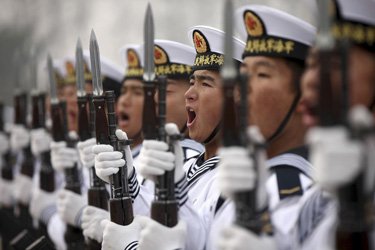China’s Maritime Silk Road
Bay of Bengal, China, Chinese Navy, Maritime Silk Road, Strategy, Sun Tzu, US Navy
Francis Pike, in the Spectator, warns that China is well on the way to adding strategic domination of the Bay of Bengal and the sea lanes to the Middle East to its ruthless appropriation of the South China Sea. Only the superior power of the US Navy stands in China’s way, but China is planning a massive naval expansion, and the US is not.
The forthcoming geopolitical struggle for supremacy between China and India will not be on land. It will be on water and a much larger body of water than Pangong Lake. The Bay of Bengal and the Andaman Sea will become the defining-battleground.
Xi Jinping’s ‘Maritime Silk Road’ policy is less talked about in the western press than ‘One Belt One Road’. The economic and military strategy is to dominate the sea lanes between China and the Middle East. As in the ancient Chinese board game of territorial control, Go, which inspired the great military theorist, Sun Tzu, Xi’s China is in the process of placing ‘stones’ (Go’s playing pieces) on Asia’s maritime seaboard that will enable it to achieve this dominance.
China’s first offshore naval port in Djibouti, adjacent to the Suez Canal, is already built. Pakistan’s Chinese-financed port of Gwadar on the Arabian Sea, guarding the approaches to the Strait of Hormuz, is another one of the stones. Closer to home, China, by its placement of airfields and naval facilities on reclaimed reefs in the Spratly Islands, has now gained probably irreversible control of the South China Sea.
From China’s viewpoint this is not enough. A third of global shipping and most of China’s oil imports pass through the Strait of Malacca between Singapore and the Indonesian island of Sumatra. As a Portuguese envoy noted in the 16th century, ‘whoever is lord of Malacca has his hands on the throat’. With the US navy embedded in Singapore’s Changi naval base, China sees the Malacca Strait as the weakest link in its maritime strategy. Thus, the digging of a $30 billion, 80-mile canal across the Kra Isthmus in southern Thailand is being mooted. The canal would bypass the US-controlled Malacca Strait and give China unimpeded access to the Andaman Sea and the Bay of Bengal. Reputedly, Chinese companies are already buying up land around the projected route of the canal. Importantly, over the past 20 years, Thailand, once a staunch US ally, has become a quasi-satellite of China.
Further inroads into the Bay of Bengal are being established by Chinese financing of the new port at Chittagong in Bangladesh, a country whose relationship to India, if not hostile, is nevertheless equivocal. It is somewhat overlooked that Bangladesh, a country of 165 million people, is now one of Asia’s fastest-growing economies.
Myanmar is even more in thrall to China. As the old Burmese saying goes: ‘When China spits, Burma swims.’ Here too China is financing a major port development on the coast of Rakhine state, home of the Rohingyas. In January, during Xi’s state visit to Myanmar, there was a joint announcement that they would push ahead with the construction of a new port in the Kyaukpyu Special Economic Zone. It is planned to link both this and the port in Chittagong by rail and road to Kunming, the capital of western China’s Yunnan Province. An oil pipeline is also planned. Meanwhile in the southern reaches of the Bay of Bengal, the People’s Republic of China and the Democratic Socialist Republic of Sri Lanka have been close allies since the 1950s.
Although India is fully alive to China’s ‘string of pearls’ strategy, the West appears to be asleep. …
With 11 aircraft carriers to China’s two, America still commands maritime Asia. However, the balance is changing rapidly. As the US congressional report on Chinese naval modernisation concluded in May, by year end the US will have 297 naval vessels, the same number as 15 years ago; China will have 360, up more than 50 per cent over the same period. A third Chinese aircraft carrier is under construction and the hull of a fourth is expected to be laid down next year.
The direction of travel is clear. The US navy could find itself in China’s wake if current trends continue. ‘There is no doubt that they’ve been investing hugely in this,’ says Nick Childs of the International Institute for Strategic Studies. ‘They’ve been outbuilding everybody.’ Unless the West wakes up to the challenge, it is likely to be outgunned within 15 to 20 years by the People’s Liberation Army navy. The European Union, of course, unwilling even to pay for its own strategic defence, is an embarrassing irrelevance. The risk for India and the West is not armed conflict with China. It is that the struggle for supremacy in Asia will be lost with hardly a shot being fired. Sun Tzu would be proud.





